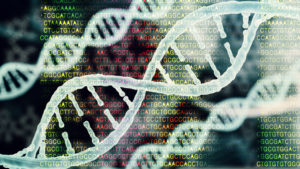
Know Your Virome? The Reason Why AI Is Helping Our Health

(photoart04/Shutterstock)
In 1901, people discovered the first virus that infects humans: yellow fever. Since then, scientists have discovered numerous novel viruses and have estimated that there are 10 nonillion (1031 ) pathogens on planet Earth. Luckily, not all of them are dangerous to humans. In fact, some microbes are proven to be beneficial to humans, which is a relief since an estimated 380 trillion viruses live inside or on our bodies. With regular new discoveries of pathogens, the sheer volume has influenced a new field of study: virome. This domain focuses on the total number of viruses that exist in a particular ecosystem to assess the risks to hosts. Given this vast amount of data, how can we accelerate our ability to process this information in an effort to boost the way we react or even predict the potential outbreak of a novel virus? Analytics and artificial intelligence (AI) hold the answer.
With a cornucopia of medical information, analytics has been a huge boon into tapping into data, driving impactful insight, and accelerating the advancement of healthcare. We have seen increased diagnostic accuracy and enhanced understanding of risk factors as well as the development of precision medicine. The explosion of wearable technology and the Internet of Things (IoT) has thrown rocket fuel on the data we collect. So much that it is estimated that medical information doubles about every 73 days. The pace is so rapid that, as humans, we struggle in just keeping up with the current research,studies, and therapeutics. As a result we have developed the perfect toolset to absorb, understand, and synthesize such a vast volume of information: AI.
In the early 1970s, researchers developed MYCIN, an early AI system that could identify which bacteria was causing an infection and recommend the appropriate drug for treatment and the dosage based on the patient’s body weight. The accuracy of MYCIN was incrementally better than a selected panel of specialists at Stanford Medical School. However, MYCIN was never put into real use. Interestingly, people were not concerned so much about the accuracy and performance of the system. Rather, it was a cumbersome effort to use MYCIN. Previously, there was no system integration of different software systems nor did personal computers exist yet., MYCIN was a standalone system that required the user to enter all the relevant information into the system. Furthermore, the internet was at its infancy, so MYCIN was completely dependent on availability of a time-shared infrastructure, meaning processing the results could take long periods of time. Thus, MYCIN was deemed “not user-friendly” and never actually deployed.
Fast forward to 2011, these infrastructure challenges are gone, there is an incredible amount of health data available. IBM Watson won the Jeopardy Challenge, reinvigorating sustained investment into AI and healthcare solutions. The renewed focus triggered a tsunami of resources into virtually every aspect of healthcare, including infectious disease research. The first foray lay in using visual recognition capabilities to identify early signs of disease, such as using AI to detect lung cancer from a chest X-ray. Over time, people taught AI about genomics, known viruses, transmission channels, and so forth to extend our AI capabilities. By 2018, AI had discovered roughly 6,000 more viruses, boosting and accelerating our ability to detect existing viruses and the development of new ones.
Historically, scientists have searched for viruses based on the genetic structures of microbes already known. Unfortunately, this method has not proven to be very effective because it doesn’t help with viruses with different genetics and the vast potential genomic combinations from even the viruses we do know. Thankfully, this is where AI excels. It can shift through billions of data points, detect subtle patterns, and classify these insights autonomously. Thus, AI is not limited to genetic sequencing of viruses that we know. It can identify potentially sequences that human beings have not detected, consider protein production from possible viruses, and analyze DNA strand gene density. As a result, AI has not only helped us discover more viruses but also how specific viruses may trigger disease, illness, or even positive health benefits.
In the world of COVID-19, AI proved to be a powerful ally in analyzing the virus, quickly understanding how it could be transmitted, and accelerating our ability to develop a vaccine. Researchers continue to use AI to help anticipate how COVID-19 might mutate and how those mutations could impact population health. These predictive capabilities have helped damper the damage caused by variants such as Omicron. In addition, there are hundreds of companies now using AI to improve drug discovery. Recently, MIT developed AI models that accelerated molecule design by a factor of almost 1,200. These types of technologies help us understand infectious disease better but also greatly reduce the time and cost of developing pharmaceuticals. The impact is so significant that the pharma industry believes it may now be cost effective to develop drugs for rare diseases, which enables better availability of therapeutics to patients who were previously overlooked in the healthcare system because of the rarity of their disease.
Taking this to a new level, many organizations are now looking to generative design to augment these AI tools. Essentially, generative design is a design exploration process. Designers or engineers input design goals into the generative design software, along with parameters such as performance or spatial requirements, materials, manufacturing methods, and cost constraints. Using our existing knowledge of viruses and the biological constraints (at least those on earth), AI could design millions upon millions of new infectious diseases, virus variants, and new life-to-life transmissions (e.g., animal to human transmission.) Then, applying probabilities and its training, the system can boil that down to a handful of likely microbes to appear in the near future. Knowing the genomics of these potential illnesses or diseases, organizations could start working on vaccines before there is an epidemic, let alone pandemic. That’s the power we’re on the cusp of achieving. That’s why analytics and AI are such crucial allies in our constant need to understand and combat harmful viruses.
About the author: Neil Sahota serves as the lead Artificial Intelligence Advisor to the United Nations and is Co-Founder of the AI for Good Global Summit, which uses AI to solve the world’s most challenging issues such as how government authorities could use AI to get ahead of the next pandemic scenario.
Related Items:
Why AI Alone Won’t Solve Drug Discovery
Can AI Find a Cure for COVID-19?
Five Ways Big Genomic Data Is Making Us Healthier































